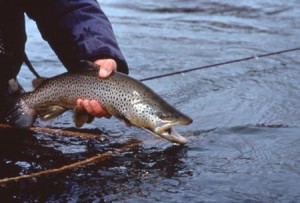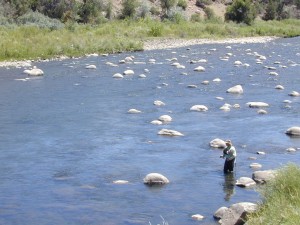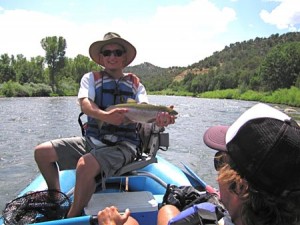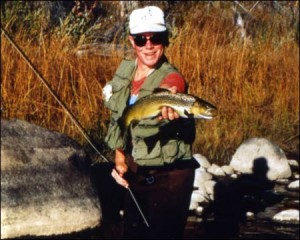- Rainbow
- Brown
Real-Time Data
Fishing Info
- Caddis
- Sculpins
- Midges
- Mayflies
- Salmonflies
- Prince
- Caddis Larva
- Sculpin/Streamer
- Parachute Adams
- Hoppers
- Elk Hair Caddis
Feb-April
July-Nov
32nd St South to
Rivera Bridge
through Durango &
upstream from Rockwood
Fly & lure Lightner Ck to Rivera Bridge, 2 fish 16″ min, Gold Medal
One of the last free-flowing rivers in the state of Colorado, the Animas River is a unique and rare treasure. With the newest and one of the best Gold Medal Water fly-fishing sections in Colorado, the Animas is a river that should be on your list of places to fish.
The Animas River is evidence of how human perception of the landscape has evolved over the past 250 years. Today the Animas Valley and the river itself seem alive, bountiful, and full of beauty. When Juan Rivera passed through this corner of Colorado in 1765, he named the river El Rio de las Animas Perdidas en Purgatorio, “The River of the Lost Souls in Hell.” To Rivera and his Spanish compatriots, the valley was remote, bleak, and had little to offer them in the way of riches.

Nothing could be further from the truth. The Animas River and its canyons are the centerpiece of southwestern Colorado’s burgeoning tourist industry. The Durango and Silverton Narrow Gauge Railroad parallels the Animas the entire way between Silverton and Durango, carrying passengers into the depths of rich forests and along the very brinks of the Animas canyons. Few who come to know the Animas are not touched by the majesty of the river and the surrounding mountains.
The Animas River is the major stream draining the high alpine terrain of the Needle Mountains. It heads in small meadows on the flanks of Cinnamon Mountain north of Silverton, then plunges through wild canyons as it carves a route between the Needle and West Needle Mountains. By the time it reaches Durango, the Animas has grown to a large river. Out of the mountains the Animas meanders through a shallow depression across broad plains. South of the New Mexico border at Farmington the Animas joins the San Juan River.
Fortunately, public access to the Animas River within the city of Durango is plentiful with almost 7 miles of river from 32nd Street Bridge to the Rivera Bridge south of town. Two parcels of private land are found in this stretch, but they are well marked. Foot and bike trails parallel the river through much of town, providing abundant easy access. Other access points are found at the 9th Street and 32nd Street city parks and at the Colorado Division of Wildlife Fish Hatchery at 151 East 16th Street. In the south part of town along U.S. 160, access is found at the chamber of commerce building and its surrounding public park and extends to the Rivera Bridge. Below Durango the Animas again crosses private land before heading across the Southern Ute Reservation.

The Animas is big water. In Durango the river is almost 100 feet wide, filled with huge rocks and deep holes. The river offers extensive riffles, freestone conditions, and stretches of pocket water. The bottom consists of gravel and cobbles. The rocks are as slick as those in any river in the West, and anglers must always be very cautious when wading. Wet wading is popular in summer, but waders are called for in the early season and in the fall.
The Animas is home to rainbows and browns. They are strong, smart trout that are doing well in the river. The big water grows some large fish, and the Animas has a reputation for large trout. Most of the fish in the river are in the 10- to 15-inch range, but the potential for a lunker is real. A past state-record brown trout weighing over 20 pounds was wrestled from the Animas in the 1950s. Fishing for browns is often a difficult proposition involving weighted streamers and hundreds of casts for a few fish. Rainbow fishing is more consistent and offers the dry-fly fishermen a chance to find plenty of good-sized trout.
The most important food source for the large trout in the Animas is sculpins. These bottom-dwelling forage fish are found in the mud and rocks throughout the river and are eagerly sought by the trout. Caddisflies are the most important aquatic insect in the Animas. Hatches begin around June 1, when they are usually masked by the later stages of runoff. The trout will actively feed if the water is high and clear, and they will often take caddis even when the water is muddy. Caddis hatches continue all summer long but tail off as the season progresses. Evening dry-fly fishing can be excellent in July and August with Elk Hair, Goddard Caddis, or Trude patterns.
 A midsummer hatch of pale morning duns stimulates trout feeding in the Animas. The hatch occurs late-morning from July until early August. Match the hatch with size 16 or 18 pale-bodied flies, such as a Light Cahill or any of the specifically designed Pale Morning Dun patterns. Size 16 to 18 nymphs—either a Pheasant Tail or dark Hare’s Ear—are effective before and during the hatch.
A midsummer hatch of pale morning duns stimulates trout feeding in the Animas. The hatch occurs late-morning from July until early August. Match the hatch with size 16 or 18 pale-bodied flies, such as a Light Cahill or any of the specifically designed Pale Morning Dun patterns. Size 16 to 18 nymphs—either a Pheasant Tail or dark Hare’s Ear—are effective before and during the hatch.
When no hatch is on, first try fishing weighted nymphs or dropping sculpin patterns along the bottom. Prince Nymphs are also a proven general attractor pattern for the Animas. If these ideas fail to work, hopper patterns are an excellent alternative. Particularly effective is a Dry Muddler in sizes 8 to 12 skittered over the surface. Fly fishing can remain excellent on the Animas through the snows of early November. The crisp, clear days of autumn, tinted with yellow aspens on the mountain slopes, offer ideal angling weather. Many anglers throughout the San Juans consider September and October the best months to be on the Animas, as well as other rivers in the area. Watch for late fall hatches of blue-winged olives and midge activity, which can occur around midday in October and November.
Below the Rivera Bridge, the Animas runs through private land and the Southern Ute Indian Reservation. Significant tribal land along La Posta Road is open to angling for those with a Southern Ute Tribal permit. For details on the location of the water, consult the latest edition of the Southern Ute Tribal Fishing Proclamation.

For many, the attraction of the Animas is the ease of access in and around Durango. There is a certain, almost rustic charm to fishing within sight of the houses on the bluffs above the river or to casting while the steam train rumbles by. But don’t be deceived into thinking fishing the Animas is easy. The big water is rough, and it takes hard work to pull a trout from it. The Animas is one river that will make you pay your dues.
The Above Information on the Animas River is excerpted from the book “Fly Fishing Southern Colorado” by Craig Martin, Tom Knopick and John Flick. It is reprinted courtesy of Pruett Publishing Company. All Rights Reserved.
Copyright 1997, 2007 by Craig Martin, Tom Knopick, John Flick

